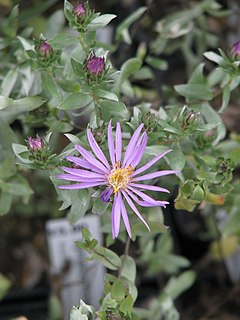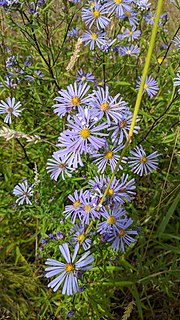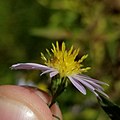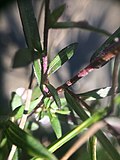
Symphyotrichum novae-angliae is a species of flowering plant in the aster family (Asteraceae) native to central and eastern North America. Commonly known as New England aster, hairy Michaelmas-daisy, or Michaelmas daisy, it is a perennial, herbaceous plant usually between 30 and 120 centimeters tall and 60 to 90 cm wide.

Symphyotrichum is a genus of over 100 species and naturally occurring hybrids of herbaceous annual and perennial plants in the composite family Asteraceae, most which were formerly treated within the genus Aster. The majority are endemic to North America, but several also occur in the West Indies, Central and South America, as well as in eastern Eurasia. Several species have been introduced to Europe as garden specimens, most notably New England aster and New York aster.

Symphyotrichum ericoides, known as white heath aster, frost aster, or heath aster, is a species of flowering plant in the family Asteraceae native to much of central and eastern North America. It has been introduced to parts of Europe and western Asia.

Symphyotrichum laeve is a flowering plant native to Canada, the United States, and Coahuila (Mexico). It has the common names of smooth blue aster, smooth aster, smooth-leaved aster, glaucous Michaelmas-daisy and glaucous aster.

Symphyotrichum cordifolium, commonly known as common blue wood aster, heartleaf aster, and blue wood-aster, is a perennial herbaceous flowering plant in the family Asteraceae native to central and eastern North America. It reaches heights of up to 1.2 meters and has bluish daisy-like flowers which bloom late-summer and fall in its range.

Symphyotrichum lateriflorum is a species of flowering plant in the aster family (Asteraceae). Commonly known as calico aster, starved aster, and white woodland aster, it is native to eastern and central North America. It is a perennial and herbaceous plant that may reach heights up to 120 centimeters and widths up to 30 cm (1 ft).

Symphyotrichum chilense is a species of flowering plant in the family Asteraceae known by the common names Pacific aster and common California aster. It is native to the west coast of North America from British Columbia to Southern California and the Channel Islands. It grows in many habitats, especially along the coast and in the coastal mountain ranges. Despite its Latin name, it does not occur in Chile. Pacific aster blooms from June to October with violet rays surrounding a yellow center.

Symphyotrichum sericeum is a species of flowering plant in the family Asteraceae native to central North America. Commonly known as western silver aster, western silvery aster, and silky aster, it is a perennial, herbaceous plant that may reach 70 centimeters tall. Its flowers have purple ray florets and pink then purple disk florets, and its leaves are firm and silvery-green.

Symphyotrichum pilosum, commonly called hairy white oldfield aster or frost aster, is a flowering plant in the family Asteraceae native to central and eastern North America. It is a perennial, herbaceous plant that may reach 20 to 120 centimeters tall. Its flowers have white ray florets and yellow disk florets.

Symphyotrichum lanceolatum is a species of flowering plant in the family Asteraceae native to North America. Common names include panicled aster, lance-leaved aster, and white panicled aster. It is a perennial, herbaceous plant that may reach 1.5 meters tall or more, sometimes approaching 2 meters. The lance-shaped leaves are generally hairless but may feel slightly rough to the touch on the top because of tiny bristles. The flowers grow in clusters and branch in panicles. They have 16–50 white ray florets that are up to 14 millimeters long and sometimes tinged pink or purple. The flower centers consist of disk florets that begin as yellow and become purple as they mature.

Symphyotrichum ciliolatum, commonly known as Lindley's aster and fringed blue aster, is a perennial herb native to Canada and the northern United States. It is also known as ciliolate wood aster and northern heart-leaved aster. The common name Lindley's aster honours John Lindley who first described the species in 1834.

Symphyotrichum robynsianum is a species of flowering plant in the family Asteraceae native to northeastern North America. Common names include Robyn's aster and long-leaved aster.

Symphyotrichum ciliatus is a species of flowering plant in the family Asteraceae native to North America and eastern Eurasia. Commonly known as rayless annual aster and rayless alkali aster, it is an annual, herbaceous plant that may reach over 70 centimeters tall. Each flower head has many whitish then pink disk florets and no ray florets ("rayless").

Symphyotrichum turbinellum, commonly called prairie aster in the United States and mauve-flowered starwort in the United Kingdom, is a species of flowering plant in the family Asteraceae native to the United States in Nebraska, Iowa, Illinois, Kansas, Missouri, Oklahoma, Arkansas, and Louisiana, primarily in the Ozarks. It has gained the Royal Horticultural Society's Award of Garden Merit.

Symphyotrichum fendleri is a species of flowering plant in the family Asteraceae native to the mid- and south-central United States, including Great Plains states and extending into Texas and New Mexico. Commonly known as Fendler's aster, it is a perennial, herbaceous plant that may reach 6 to 30 centimeters tall. Its flowers have lavender to purple ray florets and yellow then reddish purple disk florets.

Symphyotrichum subspicatum is a species of flowering plant in the family Asteraceae native to western North America. Commonly known as Douglas's aster, it is a perennial, herbaceous plant that may reach 40 to 120 centimeters tall. Its flowers have violet ray florets and yellow then reddish disk florets.

Symphyotrichum phlogifolium is a species of flowering plant in the family Asteraceae native to the eastern United States. Commonly known as thin-leaf late purple aster, it is a perennial, herbaceous plant that may reach 50 to 130 centimeters tall. Its flowers have light to dark reddish-purple ray florets and white disk florets with purple triangular lobes.

Symphyotrichum adnatum is a species of flowering plant in the family Asteraceae native to the southeastern United States and the Bahamas. Commonly known as scaleleaf aster, it is a perennial, herbaceous plant that may reach 30 to 120 centimeters tall. Its flowers have lavender ray florets and yellow disk florets.


























